The Qualcomm Snapdragon 820 Performance Preview: Meet Kryo
by Ryan Smith & Andrei Frumusanu on December 10, 2015 11:00 AM EST- Posted in
- SoCs
- Snapdragon
- Qualcomm
- Snapdragon 820
GPU Performance
Shifting gears, let’s take a look at GPU performance. As we mentioned earlier, Qualcomm isn’t disclosing much about this GPU other than that it packs quite a bit more computational power than its predecessor and should be quite a bit faster in the process. This points to a potentially significant architectural shift, but that determination will have to wait for another time.
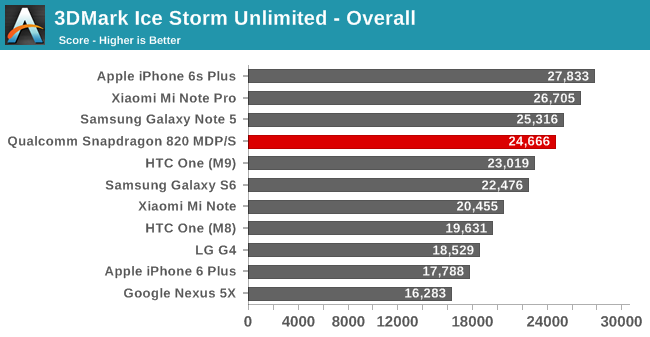
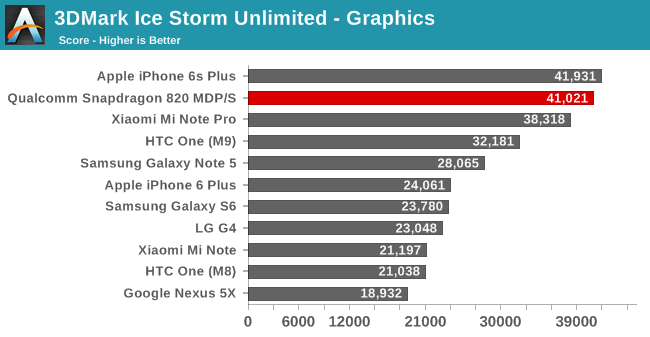
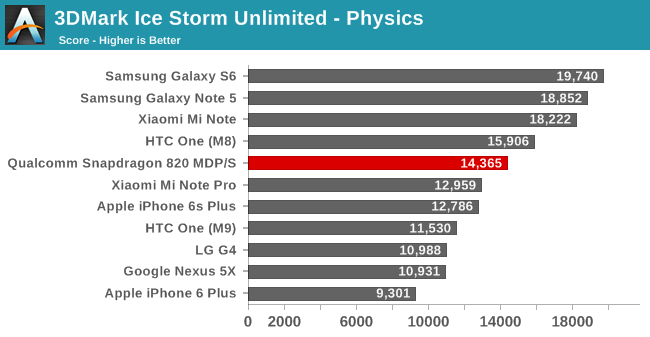
Starting with 3DMark Ice Storm Unlimited, the performance honestly doesn’t start out great. The overall score is significantly influenced by the physics score, which in turn is more concerned with the number of cores and their throughput on simple code than the ability to extract complex IPC. As a result the 4 CPU core 820 simply can’t catch up with the likes of the Samsung devices and their high-clocked big.LITTLE configurations. On the other hand the graphics score makes this the fastest Android phone to date, though relative to the 810 Mi Note Pro, perhaps not by a ton. Ultimately as this is an OpenGL ES 2.x test it’s not the most strenuous of tests these days, and comments from Qualcomm indicate that it may be a CPU-limited test on 820.
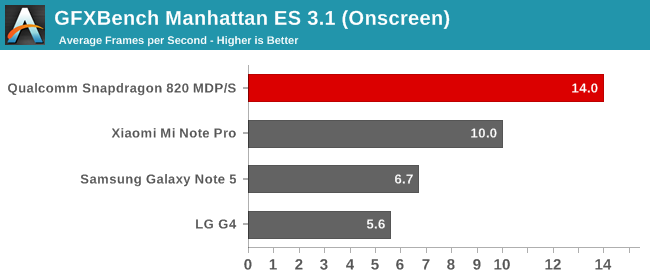
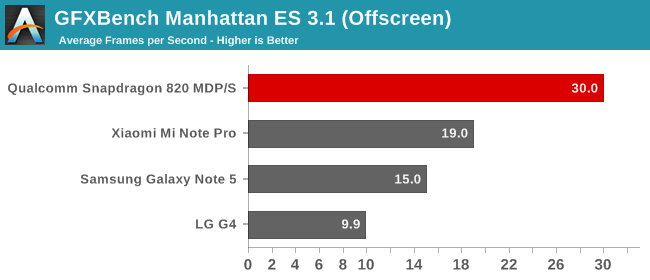
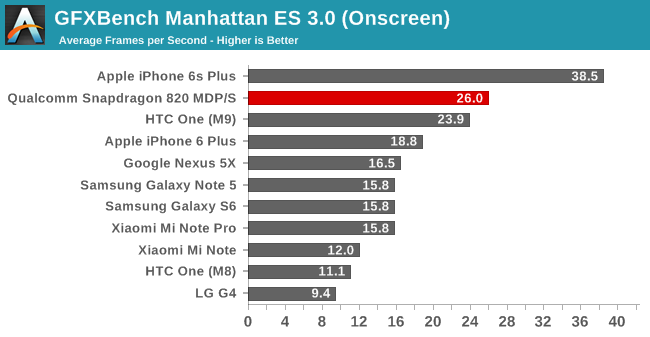
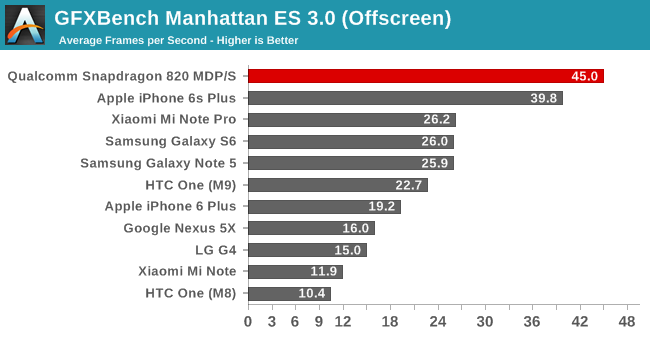
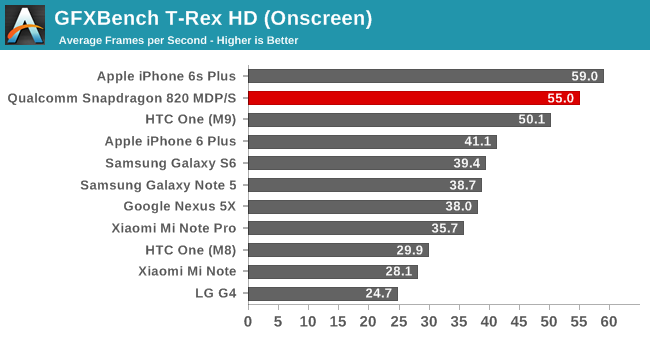
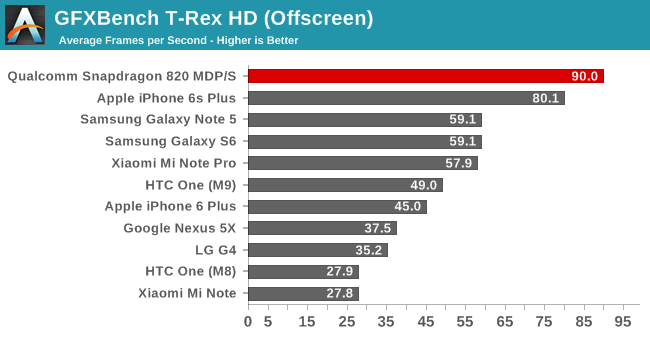
GFXBench on the other hand shows some massive gains for the 820 relative to any other Android device. In offscreen rendering mode, all 3 game tests – Manhattan ES 3.1, Manhattan ES 3.0, and T-Rex HD – put the 820 MDP/S as being 52% (or more) faster than the next-fastest Android device, either the 810 based Mi Note Pro or the Exynos 7420 based Samsung Galaxy Note 5. The single biggest jump we see is with Manhattan ES 3.0 at 72%, while the ES 3.1 version dials that back down to 52%. Even the iPhone 6s Plus, well known for its powerful GPU, is handily and consistently surpassed by the 820 here. Only due to the 6s Plus’s lower rendering resolution of 2208x1242 does it surpass the MDP/S in onscreen tests, as the latter needs to render at 2560x1600 (~50% more pixels). Qualcomm was aiming for some big GPU performance gains here and so far they are delivering.

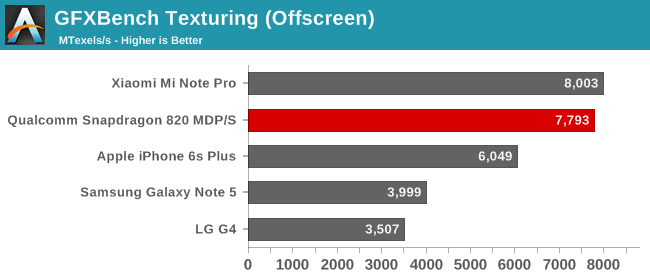
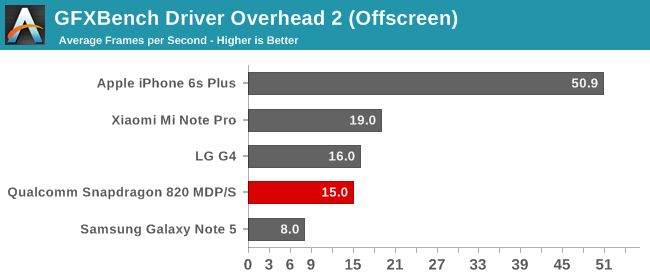
Curiously, GFXBench’s synthetic feature tests don’t show the same gains. Offscreen ALU performance is only slightly improved over the 810 (10%) or in the case of texturing is an outright regression. None-the-less full gaming performance is clearly in the 820’s favor. I’ve long suspected that the Adreno 430 GPU in the 810 had some kind of architectural bottleneck – perhaps an ALU/texture array that was difficult to fully utilize – and what we’re seeing here would back up that claim, as if that was the case then correcting it would have allowed Qualcomm to significantly boost their rendering performance while only barely changing their synthetic performance. Otherwise I find it a bit surprising that the driver overhead score is a bit worse on 820 than 810, which may be a result of the immature GPU drivers on this early device.










146 Comments
View All Comments
Andrei Frumusanu - Thursday, December 10, 2015 - link
> That doesnt just happen automagically ... the app needs to be specifically coded to do that.The app doesn't have to be coded for it. The photo processing part is done in RenderScript by stock Android APIs and that can use the GPU or fall back to the CPU if it fails to do so. Almost all recent Android devices use the GPU. The only time I saw something explicitly fall back to the CPU was on the G4 and it was just a small portion of the test.
jospoortvliet - Saturday, December 12, 2015 - link
This is interesting, perhaps add such information in the article next time?jospoortvliet - Saturday, December 12, 2015 - link
This is interesting, perhaps add such information in the article next time?tuxRoller - Thursday, December 10, 2015 - link
Who cares about die size? Sure, it can affect yield and pricing but it obviously isn't affecting then much and, in the only evaluation that matters, Apple is able to have a CPU that obliterates every other mobile chip AND is and to sustain peak performance.BTW, do you have a link to a kryo device that scores 2.1k on int? All of the ones I've seen are around 1.8k, with their total brought up by their massive memory and fp scores (totals if around 2.5k).
Wilco1 - Saturday, December 12, 2015 - link
820 vs A72 results: http://browser.primatelabs.com/geekbench3/4159755Shadowmaster625 - Thursday, December 10, 2015 - link
I would have liked to have seen a comparison of S810 MDP vs final hardware so we can get some kind of idea of the amount of optimization to expect.Ryan Smith - Thursday, December 10, 2015 - link
S810 MDP/T was a tablet, and S810 suffered badly under 20nm planar. If you want to see how it compares check out our HTC One M9 review, but it wouldn't tell us anything useful about what MDP/S -> retail will look like.cfenton - Thursday, December 10, 2015 - link
This doesn't inspire confidence. 820 looks much better than 810 at ST tasks and worse or equal in MT tasks, which seems like a good trade-off to me. However, seeing the 820 beaten in almost every benchmark by the A9 is troubling. You can't launch a flagship product six months after a competitor that performs worse than that competitor's product. Well, I guess you can, but it doesn't seem like a good move.Even if you rule out the A9, since other manufacturers can't buy those, it's not that much better than Samsung's almost year-old (by the time the 820 is in a product) SoC in the GS6.
tipoo - Thursday, December 10, 2015 - link
I'm curious what will be in the GS7. Another Exynos in the NA market? If they keep the momentum from the last one, they could perhaps punch above the 820 just like they did the 810. Not sure if their custom cores will be ready in time though?
Araa - Thursday, December 10, 2015 - link
To be frank, same thing has been happening since the A7 (even the A6). Problem is back then they used to cheat on Benchmarks or only show us bs Benchmarks like Antutu that only care about the number of cores so the numbers lied back then, they do now too just not as outrageous as before...